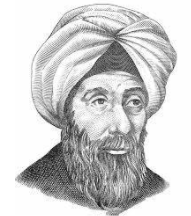NLS-Glossary
Ibn Al-Haytham
|
|
|
|
Also Known As: Birthdate: Birthplace: Death: |
"Alhazen" 354 H / c. 965 CE Basra, Iraq 432 H / 1040 CE (75) |
|
Occupation: |
Scientist and Inventor |
|
Ibn-al-Haytham '' Abu Ali al-Hasan ibn al-Haitham '' is one of the most famous physicists who discovered many laws and theories in physics; especially in optics. His one of the most notable work proves that the human eyes see because of light falling on the eyes. The previous concept was that eyes emit certain radiations which when hit an object, the eye can see it. Due to many contributions to optics, he is recognized as the father of modern optics. Ibn Al-Haytham suggested that the atmosphere of the Earth is not infinite in space but it is only around 40 kilometers high. Today, we know that around 90% of the atmosphere is below the altitude of 10 kilometers; this layer is called troposphere. He found this fact by studying the light and motion of the sun. A seven volume work on optics, Kitab al-Manazir, is considered by many to be ibn al-Haytham's most important contribution. It was translated into Latin as Opticae thesaurus Alhazeni in 1270. The previous major work on optics had been Ptolemy's Almagest Ⓣ and although ibn al-Haytham's work did not have an influence to equal that of Ptolemy's, nevertheless it must be regarded as the next major contribution to the field. The work begins with an introduction in which ibn al-Haytham says that he will begin "the inquiry into the principles and premises". His methods will involve "criticising premises and exercising caution in drawing conclusions" while he aimed "to employ justice, not follow prejudice, and to take care in all that we judge and criticise that we seek the truth and not be swayed by opinions". Also in Book I, ibn al-Haytham makes it clear that his investigation of light will be based on experimental evidence rather than on abstract theory. He notes that light is the same irrespective of the source and gives the examples of sunlight, light from a fire, or light reflected from a mirror which are all of the same nature. He gives the first correct explanation of vision, showing that light is reflected from an object into the eye. Most of the rest of Book I is devoted to the structure of the eye but here his explanations are necessarily in error since he does not have the concept of a lens which is necessary to understand the way the eye functions. His studies of optics did led him, however, to propose the use of a camera obscura, and he was the first person to mention it. Book II of the Optics discusses visual perception while Book III examines conditions necessary for good vision and how errors in vision are caused. From a mathematical point of view Book IV is one of the most important since it discusses the theory of reflection. Ibn al-Haytham gave experimental proof of the specular reflection of accidental as well as essential light, a complete formulation of the laws of reflection, and a description of the construction and use of a copper instrument for measuring reflections from plane, spherical, cylindrical, and conical mirrors, whether convex or concave. |
|
Important Characteristics of Laser
High directivity, small divergence angle of light speed, the laser beam extends only a few centimeters from a few kilometers away.
High monochromaticity, the frequency width of laser light is more than 10 times smaller than that of ordinary light.
High brightness, laser beam convergence can produce temperatures up to several million degrees.
Intercharacter space / Barcode
A narrow space (usually one module wide) that separates each barcode character from the next but is not itself a part of a barcode character. These spaces are found in discrete symbologies and are absent in continuous symbologies.
Interleaved 2 of 5 code
is a numeric only bar code. Due to the interleaving of the characters, the number of characters in an Interleaved 2 of 5 message must be even. The check character, if used, must be included in the character count Especially adapted to the poor quality of packaging materials frequently used for trade items (corrugated cardboard), it is designed to be read by a fixed or portable bi-directional scanner.
ISO (International Organization for Standardization)
is a worldwide federation of national standards bodies from some 100 countries, one from each country. ISO is a non-governmental organization established in 1947. The mission of ISO is to promote the development of standardization and related activities in the world with a view to facilitating the international exchange of goods and services, and to developing cooperation in the spheres of intellectual, scientific, technological and economic activity.
Label Gap / Barcode
The space between adjacent labels on continuous form, die cut supply.
